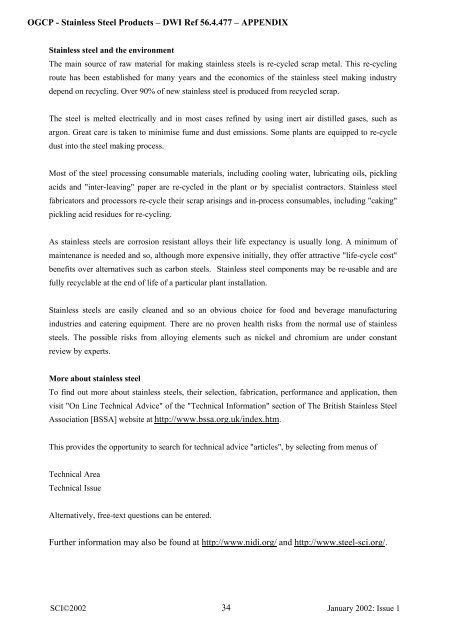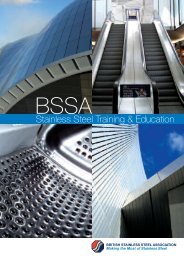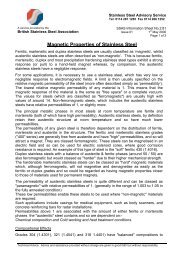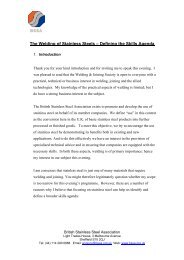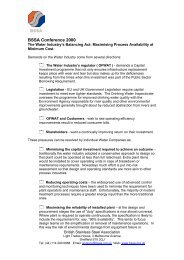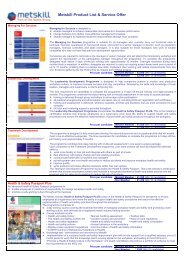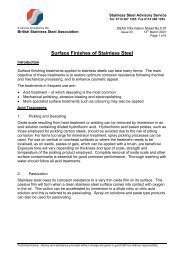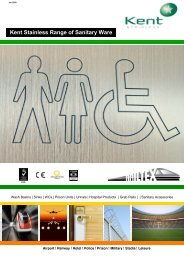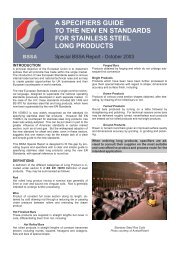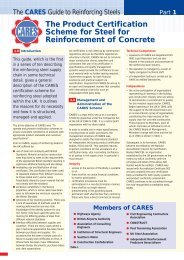Operational guidelines and code of practice for stainless steel
Operational guidelines and code of practice for stainless steel
Operational guidelines and code of practice for stainless steel
You also want an ePaper? Increase the reach of your titles
YUMPU automatically turns print PDFs into web optimized ePapers that Google loves.
OGCP - Stainless Steel Products – DWI Ref 56.4.477 – APPENDIX<br />
Stainless <strong>steel</strong> <strong>and</strong> the environment<br />
The main source <strong>of</strong> raw material <strong>for</strong> making <strong>stainless</strong> <strong>steel</strong>s is re-cycled scrap metal. This re-cycling<br />
route has been established <strong>for</strong> many years <strong>and</strong> the economics <strong>of</strong> the <strong>stainless</strong> <strong>steel</strong> making industry<br />
depend on recycling. Over 90% <strong>of</strong> new <strong>stainless</strong> <strong>steel</strong> is produced from recycled scrap.<br />
The <strong>steel</strong> is melted electrically <strong>and</strong> in most cases refined by using inert air distilled gases, such as<br />
argon. Great care is taken to minimise fume <strong>and</strong> dust emissions. Some plants are equipped to re-cycle<br />
dust into the <strong>steel</strong> making process.<br />
Most <strong>of</strong> the <strong>steel</strong> processing consumable materials, including cooling water, lubricating oils, pickling<br />
acids <strong>and</strong> "inter-leaving" paper are re-cycled in the plant or by specialist contractors. Stainless <strong>steel</strong><br />
fabricators <strong>and</strong> processors re-cycle their scrap arisings <strong>and</strong> in-process consumables, including "caking"<br />
pickling acid residues <strong>for</strong> re-cycling.<br />
As <strong>stainless</strong> <strong>steel</strong>s are corrosion resistant alloys their life expectancy is usually long. A minimum <strong>of</strong><br />
maintenance is needed <strong>and</strong> so, although more expensive initially, they <strong>of</strong>fer attractive "life-cycle cost"<br />
benefits over alternatives such as carbon <strong>steel</strong>s. Stainless <strong>steel</strong> components may be re-usable <strong>and</strong> are<br />
fully recyclable at the end <strong>of</strong> life <strong>of</strong> a particular plant installation.<br />
Stainless <strong>steel</strong>s are easily cleaned <strong>and</strong> so an obvious choice <strong>for</strong> food <strong>and</strong> beverage manufacturing<br />
industries <strong>and</strong> catering equipment. There are no proven health risks from the normal use <strong>of</strong> <strong>stainless</strong><br />
<strong>steel</strong>s. The possible risks from alloying elements such as nickel <strong>and</strong> chromium are under constant<br />
review by experts.<br />
More about <strong>stainless</strong> <strong>steel</strong><br />
To find out more about <strong>stainless</strong> <strong>steel</strong>s, their selection, fabrication, per<strong>for</strong>mance <strong>and</strong> application, then<br />
visit "On Line Technical Advice" <strong>of</strong> the "Technical In<strong>for</strong>mation" section <strong>of</strong> The British Stainless Steel<br />
Association [BSSA] website at http://www.bssa.org.uk/index.htm.<br />
This provides the opportunity to search <strong>for</strong> technical advice "articles", by selecting from menus <strong>of</strong><br />
Technical Area<br />
Technical Issue<br />
Alternatively, free-text questions can be entered.<br />
Further in<strong>for</strong>mation may also be found at http://www.nidi.org/ <strong>and</strong> http://www.<strong>steel</strong>-sci.org/.<br />
SCI©2002 34<br />
January 2002: Issue 1


